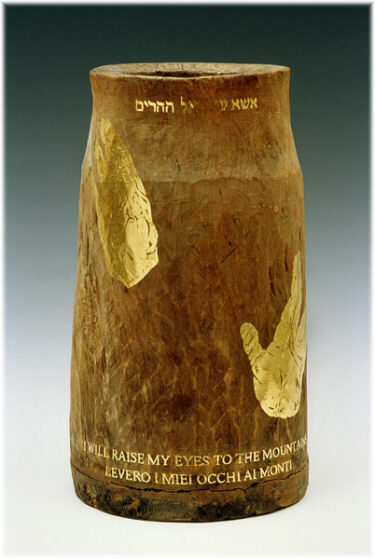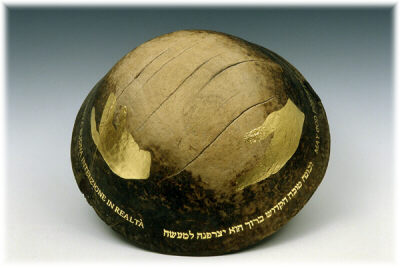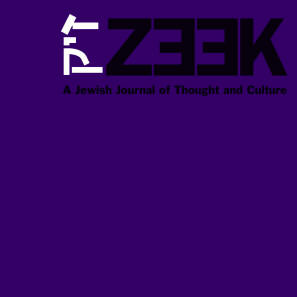 April 06
April 06
Remembering Miriam: Beth Grossman's "Our Mother Mary Found"
Sarah Glover
"It's beautiful. It's brilliant. We'll never show it."
 Such was the response California artist Beth Grossman received when presenting her latest body of work to Jewish museums and galleries across the United States. With the exception of the Jewish Community Center of San Francisco, all of the institutions she contacted rejected her work, at times questioning its Jewishness. This was in stark contrast to the reception many of these institutions gave Grossman's earlier work, Passages, an installation piece that opened at Ellis Island, traveled for eight years, and showed at prestigious venues such as the National Jewish Museum in Washington, the National Museum of American Jewish History in Philadelphia, and the San Francisco Jewish Museum. Like her earlier work, this latest project deals with issues of Jewish heritage and identity in the life of a Jewish woman. But whereas the Ellis Island project centered upon the artist's great-grandmother, and her immigration from Russia to the United States, Grossman's recent work, Our Mother Mary Found, tells the story of another, more famous, Jewish woman: Mary (Miriam), the mother of Jesus.
Such was the response California artist Beth Grossman received when presenting her latest body of work to Jewish museums and galleries across the United States. With the exception of the Jewish Community Center of San Francisco, all of the institutions she contacted rejected her work, at times questioning its Jewishness. This was in stark contrast to the reception many of these institutions gave Grossman's earlier work, Passages, an installation piece that opened at Ellis Island, traveled for eight years, and showed at prestigious venues such as the National Jewish Museum in Washington, the National Museum of American Jewish History in Philadelphia, and the San Francisco Jewish Museum. Like her earlier work, this latest project deals with issues of Jewish heritage and identity in the life of a Jewish woman. But whereas the Ellis Island project centered upon the artist's great-grandmother, and her immigration from Russia to the United States, Grossman's recent work, Our Mother Mary Found, tells the story of another, more famous, Jewish woman: Mary (Miriam), the mother of Jesus.
The Virgin Mary is, of course, hardly neutral territory for any artist. Even apart from the obvious religious taboos and sentiments, the aesthetic constraints are daunting in light of an iconographic tradition, forged by church doctrine, that hasn't changed much over the past 1000 years. A quick glance through the illustrations accompanying Jaroslav Pelikan's, Mary through the Centuries, reveals just how conservative that tradition is. Even Chris Ofili's controversial painting of the Virgin, adorned with elephant dung, retained the traditional, blue-cloaked figure -- the same one, albeit white-skinned and blue-eyed, that appears in bathtub shrines across America.
Little trace of that graven image remains in Grossman's work, which reclaims the iconic figure of the Virgin Mary as a Jewish mother, removing her from the gilded tabernacles and hagiographic narratives that usually confine and define her. Our Mother Mary Found is an installation deceptively simple in form and decoration. Ten found objects, rustic wooden tools and vessels, are transformed, by the appearance of gilded hands and illuminated Jewish prayers, from mundane artifacts into sacred objects. The hand-crafted tools correspond, either visually or conceptually, to ten events in Mary's canonical life. The conception of Mary's son is recalled by the uterus-shaped butter churn, whose ability to transform milk into butter also speaks to the transformation that occurs within the womb. An overturned bowl recalls Mary's pregnant belly and serves as a symbol of abundance. An upright plane represents the cross upon which her son was executed. Mary's own death is recalled by a sieve, symbolizing the thin mesh that separates life from death. These are the kind of tools the artist imagined Mary might have used, or her husband and son might have made. Most still bear the marks of their original fabrication and long use. Chisel marks and abrasions dent the hewn forms, prompting the viewer to imagine the many different pairs of hands through which these objects have passed: from the first pair that made them to the final pair that used them. Now a very different set of hands, rendered in gold leaf, embraces these tools and remakes them once again.
 The gilded hands belong to Mary, and their carefully choreographed gestures are taken directly from medieval, renaissance and baroque paintings depicting her joys and sorrows. Grossman recognizes that these gestures, the most expressive elements in traditional Marian imagery, functioned as a standardized code. Each of the episodes in Mary's life are referred to by a specific gesture, a gesture that reveals the behavioral norms of the ideal mother: submission, devotion, humility, self-sacrifice and suffering. Alongside the hands, Grossman presents Mary's devotional life in gilded texts taken from an eighteenth-century prayer book for Jewish women. Transcribed in three languages, Hebrew, English and Italian, these are the prayers the artist imagines Mary reciting at specific moments in her life and they present a linguistic representation of the changing geographical and historical context for those prayers.
The gilded hands belong to Mary, and their carefully choreographed gestures are taken directly from medieval, renaissance and baroque paintings depicting her joys and sorrows. Grossman recognizes that these gestures, the most expressive elements in traditional Marian imagery, functioned as a standardized code. Each of the episodes in Mary's life are referred to by a specific gesture, a gesture that reveals the behavioral norms of the ideal mother: submission, devotion, humility, self-sacrifice and suffering. Alongside the hands, Grossman presents Mary's devotional life in gilded texts taken from an eighteenth-century prayer book for Jewish women. Transcribed in three languages, Hebrew, English and Italian, these are the prayers the artist imagines Mary reciting at specific moments in her life and they present a linguistic representation of the changing geographical and historical context for those prayers.
Grossman has said she intended "to give a sense of Mary's physical life," showing "tools she, Joseph and Jesus could have used" but also "wanted to convey a sense of the sacred." The project is informed by the aesthetics of enshrinement, and is, as the artist states, "sacred art." The use of gold leaf recalls painted icons, with their gilded backgrounds, manuscript pages with their illuminated text, and reliquaries with their bejeweled surfaces. Yet its limited use, on the surface of aniconic objects, prohibits the gold from transforming the objects into idols. The gold leaf also serves as one of the few reminders of the artist's own labor. An unforgiving material, gold leaf must be applied at just the right time, under just the right environmental circumstances. It took Grossman over a year to complete the gilding. She found that the work itself became contemplative and reverential, "With gold leaf, you have to slow down, it's a very meditative process."
Obviously, though, the Virgin Mary is challenging for more than merely aesthetic reasons. Why is a self-identified "Jewish artist" creating a work about a Christian icon? Is this Jewish art, or were the Jewish museums right to exclude it from consideration?
Top: ANNUNCIATION After Lorenzo Lotto 1480-1556
Bottom: MADONNA AND CHILD After Bernardo Zenale 1460-1526








